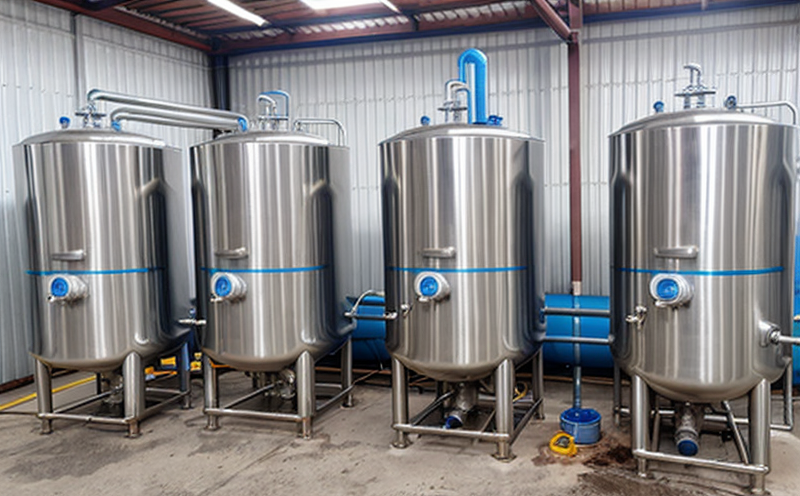ASTM D5465 Algal Growth Potential Test in Cooling Water Systems
The ASTM D5465 Algal Growth Potential (AGP) test is a critical method used to assess the potential for algal growth within industrial cooling water systems. This test is particularly relevant for facilities that rely on closed-loop or open-cycle cooling systems, as it provides valuable insights into the environmental conditions conducive to algal proliferation.
Algae can have significant implications for the efficiency and longevity of such systems. In open-cycle cooling systems, algae growth in the cooling towers can lead to reduced heat transfer efficiency, clogging of pipes, and increased maintenance costs. Additionally, excessive algae can compromise the quality of the water discharged into the environment, potentially leading to regulatory non-compliance.
The ASTM D5465 AGP test simulates real-world conditions by exposing a sample of cooling water to controlled light and temperature conditions that are optimal for algal growth. The test measures the amount of photosynthetically active radiation (PAR) absorbed by algae in the presence of this water, which is directly related to the potential for algal growth.
The first step in preparing for an ASTM D5465 AGP test involves collecting a representative sample from the cooling water system. This should be done at various points within the system to ensure that all relevant parameters are captured. The collected samples must then be stored under specific conditions, typically in a dark container with minimal light exposure to prevent premature algal growth.
The actual testing process begins by inoculating the sample with a standardized concentration of photosynthetic bacteria and placing it into an illuminated incubation chamber. This chamber is designed to mimic natural sunlight conditions, providing the necessary PAR for algal growth. The temperature within the chamber should be carefully controlled to ensure that it closely matches environmental conditions.
During the incubation period, the test measures the absorption of photosynthetically active radiation by the algae present in the sample. This is done using a photometer capable of detecting changes in light intensity as PAR is absorbed. The results are then compared against standard reference values to determine the algal growth potential.
Understanding the implications of algal growth within cooling water systems is essential for effective management and maintenance strategies. Regular testing allows facility operators to identify potential issues early, reducing the risk of costly disruptions and environmental impacts. By implementing preventive measures based on AGP test results, facilities can enhance operational efficiency, extend equipment lifespan, and minimize ecological footprint.
The ASTM D5465 AGP test is a cornerstone for ensuring compliance with relevant industry standards and best practices in water management. It enables facilities to take proactive steps towards sustainable operations by addressing the root causes of algal growth before they become significant problems.
Industry Applications
- Facilities using open-cycle cooling towers for industrial processes.
- Power plants with large-scale cooling systems.
- Manufacturing units that rely on extensive water-based cooling solutions.
- Companies operating in regions prone to high algal growth due to favorable environmental conditions.
The ASTM D5465 AGP test is particularly valuable for facilities where the quality of cooling water can directly impact operational efficiency and compliance with regulatory standards. This method helps in identifying potential issues early, allowing operators to implement targeted measures to mitigate risks associated with algal growth.
Why Choose This Test
- The ASTM D5465 AGP test provides a clear picture of the algal growth potential within cooling water systems, enabling proactive management strategies.
- It helps in identifying the specific conditions that foster algal growth, allowing for targeted interventions to prevent excessive proliferation.
- The test is internationally recognized and widely accepted, ensuring consistency across different facilities and jurisdictions.
- By using this method, organizations can achieve regulatory compliance while also enhancing their environmental stewardship efforts.
Choosing the ASTM D5465 AGP test ensures that facility operators have a robust tool for monitoring and managing algal growth in cooling water systems. This not only supports operational efficiency but also contributes to sustainable practices, reducing both economic costs and environmental impact.
Environmental and Sustainability Contributions
The ASTM D5465 AGP test plays a crucial role in promoting sustainability within industrial settings by addressing key environmental concerns related to algal growth. By identifying the potential for algal proliferation early, facilities can implement preventive measures that reduce the need for reactive interventions later on.
One of the primary benefits of this testing method is its ability to minimize ecological impact. When excessive algae are allowed to grow in industrial cooling water systems and subsequently discharged into natural water bodies, it can lead to oxygen depletion, harming aquatic life. By preventing such issues through timely intervention, facilities can contribute positively to environmental conservation efforts.
From a broader sustainability perspective, the ASTM D5465 AGP test supports long-term operational efficiency and cost-effectiveness. By addressing algal growth early, organizations can avoid costly repairs and replacements of equipment damaged by algae. This proactive approach also helps in optimizing resource utilization, aligning with global sustainability goals.





